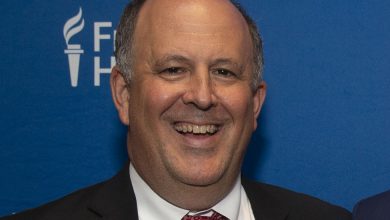Fixing Social Security and Medicare: Where the Parties Stand

The unusual back and forth between President Biden and Republican lawmakers on live television during last week’s State of the Union address kicked off a high-stakes political debate about repairing Social Security and Medicare.
The noisy exchange — provoked by Mr. Biden’s charge that some Republicans want to “sunset” Medicare and Social Security — may have left viewers wondering where politicians stand on fixing these critical programs, which face financial problems in the years ahead. Theatrics aside, both parties have detailed their ideas in legislative and campaign proposals.
Most Democrats are unified behind proposals that would raise new taxes on the wealthy and expand benefits; Republicans are less united, but conservatives have outlined changes that would shrink benefits and reduce eligibility.
Any changes enacted by Congress will affect current retirees and people getting close to retirement — but younger workers, too, since changes to these programs typically are phased in over many years.
Social Security
Social Security pays benefits out of its retirement and disability trust funds. Think of these as checking accounts, with funds flowing in primarily from the Federal Insurance Contributions Act, or FICA, which levies a 12.4 percent tax on wages that is split by employers and workers. The combined trust fund accounts are projected to be depleted in 2035.
Lower birthrates mean that fewer workers are paying into the system today than the growing number of people retiring and collecting benefits. Another cause of the shortfall is rising income inequality. Social Security collects FICA contributions only up to a certain wage ($160,200 this year), leaving a growing share of wages outside the taxable base.
Unless Congress acts by 2035, Social Security funds will be sufficient to pay only about 80 percent of the program’s obligations to retirees and disabled workers. The resulting benefit cut — estimated at 20 to 25 percent over time — would affect current and future beneficiaries alike, pushing up poverty rates among retirees by 60 percent, according to projections by the Urban Institute.
The cuts would be especially painful for today’s younger workers and people of color, according to the institute’s projections. If the financing gap is left unaddressed, 49 percent of workers born from 1980 to 1989, or early millennials, would lack the income they need to meet basic living expenses — a rate that jumps to 53 percent for Black adults in that age group, and 62 percent for Hispanic adults.
“People of color depend disproportionately on Social Security, so if benefits are cut it’s going to be especially devastating for them,” said Richard Johnson, senior fellow and director of the Urban Institute’s Program on Retirement Policy.
Aside from the 2035 problem, Social Security is already on track to replace less pre-retirement income for today’s younger workers than for today’s retirees. That is attributable, mainly, to the last major changes to the program, which were enacted in 1983. That legislation put in motion a gradual increase in the Full Retirement Age, or F.R.A. — the age when you qualify to receive 100 percent of your benefit. Before 1983, the F.R.A. was 65, but for everyone born in 1960 and later, it is 67. Every year increase in the F.R.A. equates roughly to a 6.5 percent cut in benefits.
Health Care in the United States
- The Cost of Miracle Drugs: A wave of innovative medicines promise to cure devastating diseases. But when prices are too high, patients have to hunt for other ways to pay.
- Medicare: The Biden administration announced a rule targeting Medicare private plans that overcharge the federal government. The change strengthens the ability to audit plans and recover overpayments.
- ‘Hospital at Home’ Movement: In a time of strained capacity, some medical institutions are figuring out how to create an inpatient level of care outside of hospitals.
- Omnibus Bill: The giant spending bill passed by Congress kept the government open. But it also quietly rewrote huge areas of health policy.
Workers have responded, to some extent, by delaying their benefit claim. In 2021, 31 percent of retired worker claims were made by people age 62, down from 60 percent in 1998, according to an analysis of Social Security Administration data by Mr. Johnson. But 84 percent of workers had claimed benefits by age 66.
Republicans and Democrats have starkly different visions for how to avert insolvency for the trust funds.
As a candidate for president, Mr. Biden proposed adding a new tier of payroll tax contributions for people with incomes over $400,000. That would extend solvency by roughly five years. The Social Security 2100 Act, sponsored by Representative John Larson, Democrat of Connecticut, enjoys widespread support in the Democratic caucus. It mirrors President Biden’s payroll tax proposal.
Social Security 2100 includes a 2 percent across-the-board boost in benefits, and it would shift the annual cost-of-living increase to a more generous formula. It also includes targeted benefit increases such as a new minimum benefit level for very low income seniors, and improved benefits for widows and widowers. It also would provide caregiver credits that increase benefits for people who take time out of the work force to care for dependent family members.
Just this week, Senators Bernie Sanders of Vermont and Elizabeth Warren of Massachusetts introduced the latest version of their own Social Security proposal. It would extend solvency by 75 years, give nearly all beneficiaries an increase of $200 per month through a revision in the benefit formula and adopt a more generous annual cost-of-living increase. It would be funded by applying current FICA tax rates to incomes above $250,000, and with two new taxes on investment income.
How about the Republicans’ plans?
President Biden provoked an uproar by calling out a proposal made last year by Senator Rick Scott of Florida that calls for “all federal legislation to sunset in five years” and would “force Congress to issue a report every year telling the public what they plan to do when Social Security and Medicare go bankrupt.” Senator Ron Johnson of Wisconsin also has suggested that Congress review spending on the two programs regularly.
Mr. Scott dropped Social Security and Medicare from his proposal on Friday, and it had not been widely embraced by his party — but neither has any other plan. Former President Donald J. Trump recently warned Republicans not to cut Social Security or Medicare benefits, and House Speaker Kevin McCarthy has said that cuts are “off the table.”
“I think there’s no consensus at all,” said Andrew G. Biggs, a senior fellow at the American Enterprise Institute and a leading conservative expert on Social Security policy. “Republicans are saying things like, ‘I don’t want to cut benefits, and I don’t want to raise taxes, either. And my mother is on Social Security.’ It’s all at the surface level.”
The most substantive Republican Social Security plan comes from a group of conservative lawmakers in the House of Representatives as part of a broader federal budget plan. The group, the Republican Study Committee, calls for significant benefit cuts for all but the lowest-income workers by gradually raising the F.R.A. to 70, and through changes to the benefit formula that would sharply cut benefits for middle-income and affluent workers.
After that adjustment, the group proposed linking the F.R.A. to any further gains in life expectancy.
Those reductions mirror ideas about Social Security advanced by Mr. Biggs and other conservatives. “Social Security should be much more focused on low earners,” Mr. Biggs said. “Running this retirement system forever for middle- and upper-income people who would easily save for retirement on their own just doesn’t make sense to me — there are other things that the government could be doing.”
Mr. Johnson worries that focusing Social Security on low-income workers would threaten the program’s future. “Social Security is a social insurance program — not a poverty reduction program,” he said. “If we reduce benefits for higher-income people, that fundamentally changes the nature of the program — and it raises the risk that Social Security could wither like other poverty reduction programs, and lose some of its popular support if everyone doesn’t have a stake in it.”
Lawmakers also have different visions for the potential process for an overhaul.
Senators Mitt Romney, Republican of Utah, and Joe Manchin, Democrat of West Virginia, have championed legislation that would establish congressional “rescue committees” to come up with proposed changes to Social Security and Medicare for a vote by the full Congress, which would have no power to amend them. The so-called Trust Act enjoys some bipartisan support, although the White House recently condemned the idea as a “death panel” for the two programs.
Progressive Democrats are pushing for an open legislative process. “If you’re doing what the American people want you to do, which is to expand benefits and require the wealthy to pay more, you can do that in the open,” says Nancy Altman, co-director of Social Security Works, a progressive advocacy group. “Politicians want to do this behind closed doors to avoid accountability.”
Medicare
As with Social Security, the two parties differ sharply on the future of Medicare.
When he ran for president in 2020, Mr. Biden proposed expanding the program by reducing its eligibility age to 60 from 65. And the Inflation Reduction Act, signed into law last summer, strengthens benefits offered through the Part D prescription drug program by capping the cost of insulin for diabetics, adding a hard out-of-pocket limit on drug spending and empowering Medicare to negotiate drug prices. The administration also proposed expansion of Medicare dental, vision and hearing coverage under the Build Back Better bill, which failed to pass.
The most immediate issue confronting Medicare is solvency of its Hospital Insurance Trust Fund,which funds Part A benefits. Unlike other parts of Medicare, the trust fund is financed mainly through a FICA tax of 2.9 percent, split between employers and workers; parts B (for outpatient care) and D are financed through a combination of general government revenue and enrollee premiums.
The trust fund is forecast to run dry in 2028 — at that point, it would have sufficient revenue to meet 90 percent of its obligations. Shortfalls in this fund are nothing new — they generally stem from rising health care costs. But the proximity to this financial cliff makes the problem urgent. Possible solutions include adding new revenue, cutting benefits or reducing payments to health care providers.
In his State of the Union address, Mr. Biden pledged to extend the trust fund’s solvency by “at least two decades.” A White House spokesman said that further details on the president’s plan would be in his budget proposal for the coming year, which will be released on March 9.
An idea some progressives favor is to redirect some or all of the revenue raised by the 3.8 percent Net Investment Income Tax on high-income individuals into the Part A trust fund.
Currently, revenue collected through that tax goes into the government’s general coffers. That could shift enough money over a 10-year period into Part A to eliminate much of the shortfall.
The Republican Study Committee proposes addressing the financial pressures facing Medicare by increasing the program’s eligibility age, tying it to the Social Security F.R.A. The group, and other conservative policy advocates, also have pressed for further privatization of Medicare as a solution, for example the introduction of “premium support” — or vouchers — that seniors would use to shop for various health care plans.
Whatever direction Congress chooses, experts note that taking action soon would be beneficial. “Your options become more narrow the less time you have to implement changes,” said Gretchen Jacobson, vice president for Medicare at the Commonwealth Fund, a foundation focused on health care policy. “Some of these policy changes take a while to take effect.”





